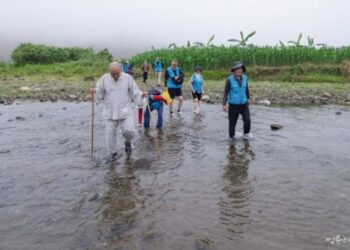May 29, 2025 – Day 102 of the 100-Day Dharma Talk, Sutra Lecture Wrap-up, Memorial Service for Dharma Teacher Hyangryu, Buddhist Social Studies Course Lecture 23
Hello. Today marks the 102nd day of Venerable Pomnyun Sunim’s 100-Day Dharma Talk. Today is the day to wrap up the sutra lectures and the Buddhist Social Studies Course. A memorial service was also held for Dharma Teacher Hyangryu, who passed away last April.
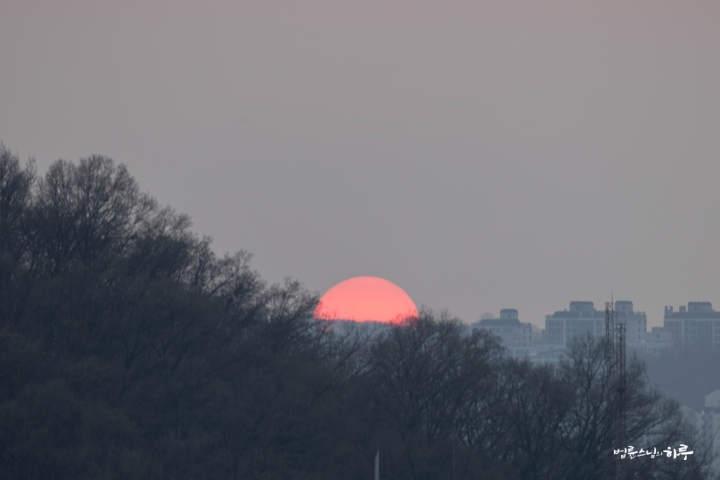
After completing morning practice and meditation, Sunim headed to the Seocho 3-dong Community Center at 6 AM to cast an early vote for the 21st presidential election.
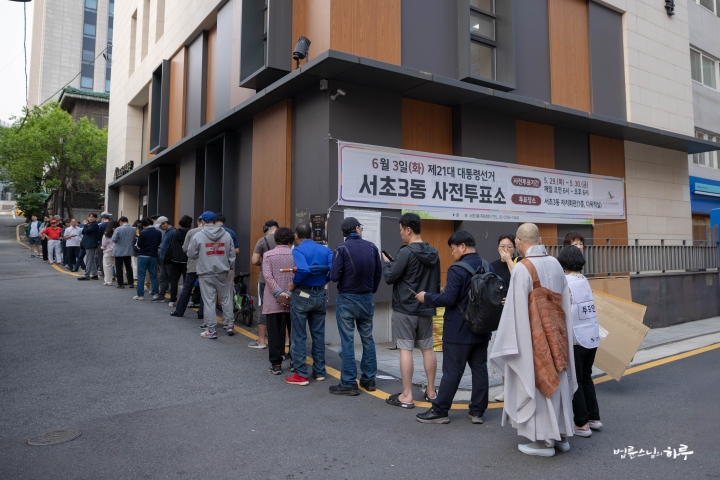
Despite the early hour, many citizens were already lined up in front of the community center to vote. Sunim also stood in line and waited for his turn.
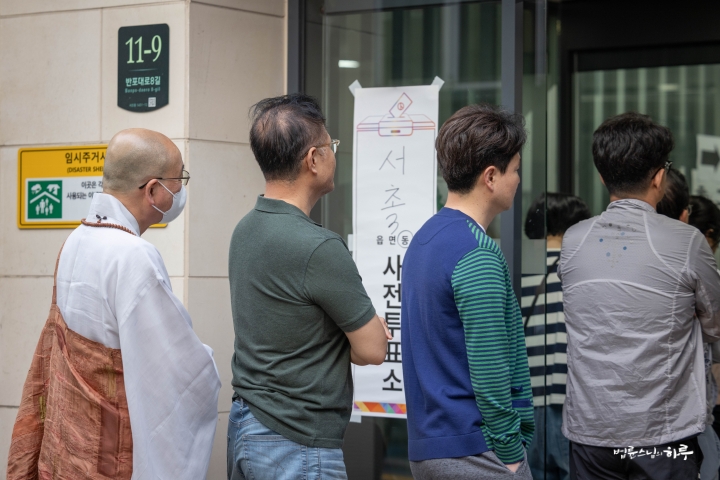
After casting his precious vote, Sunim filmed a video encouraging voter participation in front of the early voting station.

“Voting is a precious right through which citizens can exercise their sovereignty. Rights must be exercised. Through this election, we will elect a president who will lead the Republic of Korea for five years. Depending on your choice, the fate of this country could improve or worsen. Since exercising your rights is essential for the development of the Republic of Korea, please don’t abstain – I hope every single person will vote.”
After completing the early morning vote, Sunim headed to the Jungto Social and Cultural Center.
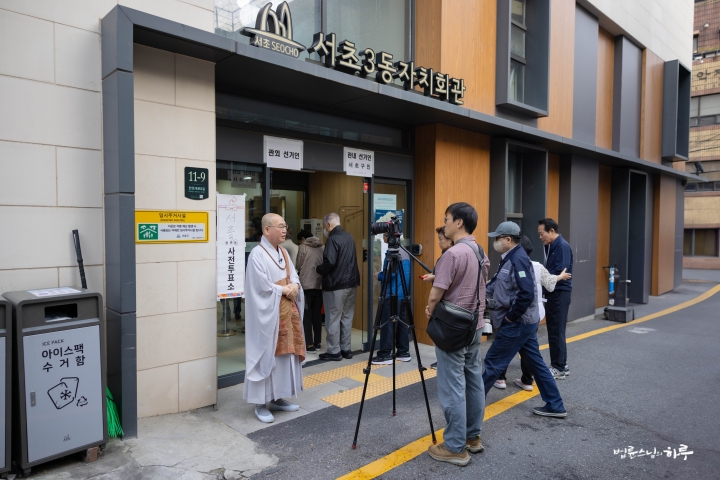
The sutra lecture began at 10:15 AM in the Dharma Hall on the third floor. About 110 people attended in person, and approximately 560 people connected via online live stream. After the assembly requested the teaching with three prostrations, Sunim ascended the Dharma seat.

This session was dedicated to concluding the sutra lectures that had been conducted over the past 100 days. Feeling a sense of regret that the lectures were ending, the students listened even more attentively than usual, focusing intently on Sunim’s teaching.
Sunim suggested that everyone chant together the Diamond Sutra they had studied. The students chanted the Diamond Sutra in unison with the sound of the moktak wooden instrument.
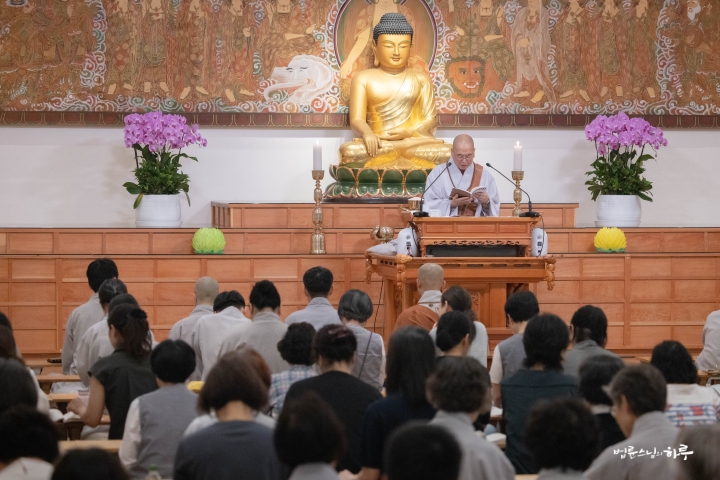
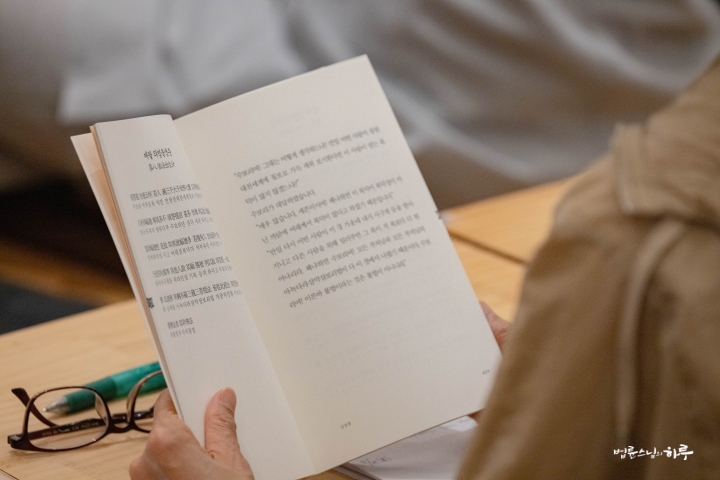
After completing the Diamond Sutra chanting, Sunim summarized the core essence of the Diamond Sutra.
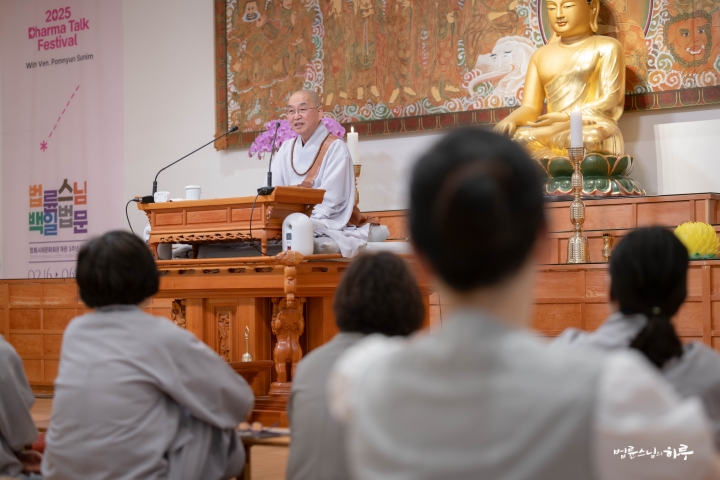
“Today marks the conclusion of our Diamond Sutra and Heart Sutra lectures. As this is our final gathering, I will wrap up by summarizing the key points of both sutras.
‘How should good men and women who have aroused the mind of Anuttara Samyak Sambodhi subdue their minds and how should they abide?’
This is the main question of the Diamond Sutra. Here, the mind of Anuttara Samyak Sambodhi refers to supreme enlightenment, or unsurpassed perfect enlightenment. When one realizes this Dharma, all afflictions disappear and one reaches a state of tranquil stillness, namely nirvana. So Subhuti’s question essentially means, ‘What kind of mind should we cultivate to reach such a state?’ To this question, the Buddha responds: ‘Arouse the mind to save all sentient beings. However, even if you save all sentient beings, know that in truth not a single sentient being has been saved.’ This is the core teaching of the Diamond Sutra.
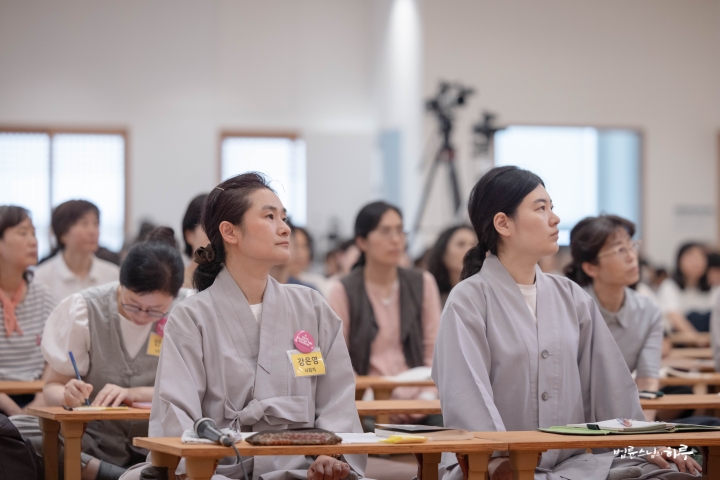
The Path to True Freedom as Taught by the Diamond Sutra
If one says ‘This is the Dharma,’ one is attached to the notion of self, the notion of person, the notion of sentient beings, and the notion of lifespan. Even if one says ‘This is not the Dharma,’ one is still attached to the notion of self, the notion of person, the notion of sentient beings, and the notion of lifespan. If one says ‘This is the truth,’ it is not the truth, and if one says ‘This is not the truth,’ it is also not the truth. This is because truth cannot be fixed as ‘this’ or ‘that.’ This is called ‘No Everlasting Abiding Dharma.’
No Everlasting Abiding Dharma is sometimes expressed as the ‘Middle Way’ in early sutras, and later expressed as ’emptiness.’ When one understands this, one realizes that all statements that define concepts in fixed terms—such as ‘That is the soul,’ ‘That is the true self,’ or ‘That is Buddha-nature’—contradict No Everlasting Abiding Dharma. When one properly understands No Everlasting Abiding Dharma, one does not make definitive statements about anything. One neither says ‘it exists’ nor ‘it doesn’t exist.’ Since everything arises through causes and conditions, one can only say ‘under these conditions, it is like this.’ However, if something is established as an absolute truth transcending time and space, it is no longer the truth.
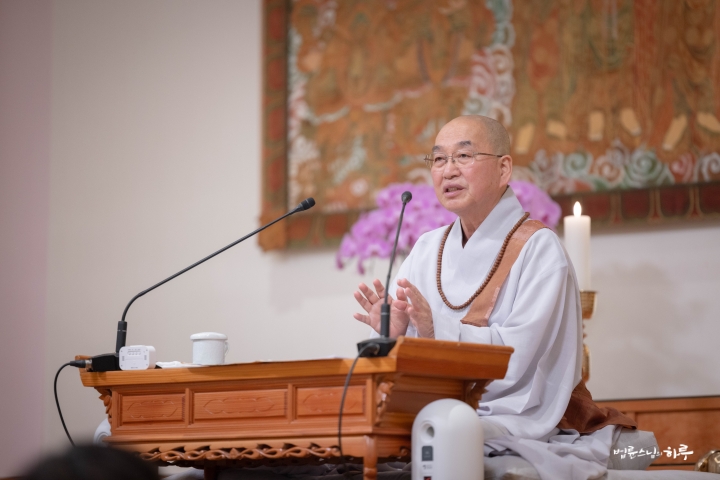
Because we are always living in the habit of making definitive judgments, the concept of “No Everlasting Abiding Dharma” may be confusing at first. However, contradictions always follow such definitive thinking. When you embody the principle of “No Everlasting Abiding Dharma,” the contradictions in your mind are resolved and your afflictions subside, just like untangling a knotted thread. However, if you only understand “No Everlasting Abiding Dharma” intellectually and apply it in your own way, you risk falling into reckless behavior, like saying “it can be this or that depending on how you look at it.” Please be mindful of this point, and I hope you all attain true freedom and unobstructed liberation through the teachings of the Diamond Sutra.”
Next, everyone chanted the Heart Sutra together. After the chanting ended, Sunim summarized the key points of the Heart Sutra that had been studied so far.
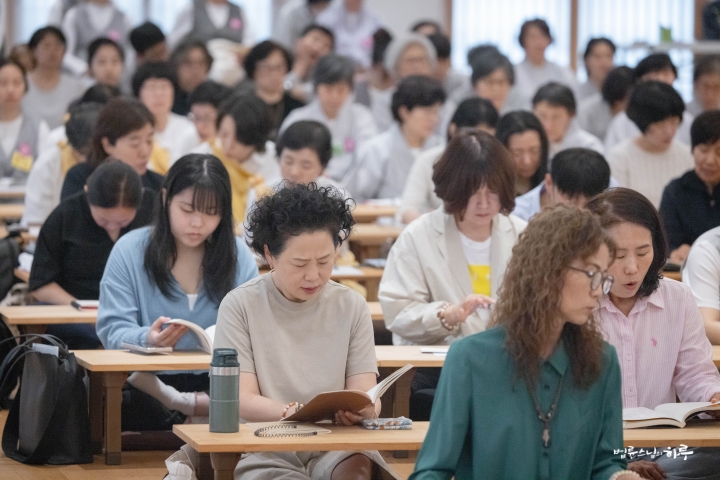
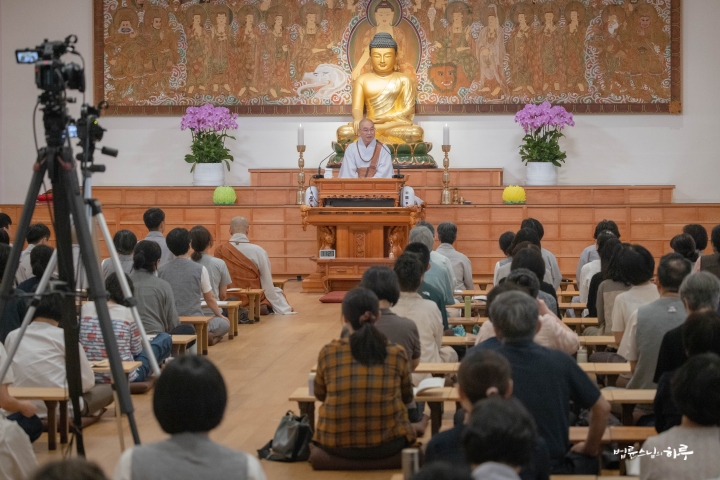
“The Heart Sutra can be said to summarize the philosophy of the Diamond Sutra. This is because both sutras present the path of Prajnaparamita practice.
The Mahayana Wisdom Revealed by the Heart Sutra
The main body of the Heart Sutra is divided into three major parts. First, it theoretically expounds the Prajna philosophy and the concept of emptiness in Mahayana Buddhism. It proves through various examples and logic that all dharmas are empty. The world of emptiness is the world of dependent origination, and there is no substance within it. There is no arising or ceasing, no increasing or decreasing, no purity or defilement.
Second, it critically points out the attachment to dharma in Hinayana Buddhism. Hinayana practitioners cling to dharma and argue, saying ‘This is the dharma,’ or ‘No, that is the dharma.’ From the Mahayana perspective, dharma cannot be discriminated as ‘this’ or ‘that,’ and one must transcend discriminating mind itself. Therefore, it states that the five aggregates, twelve sense bases, eighteen realms, twelve links of dependent origination, Four Noble Truths, and even enlightenment itself are all empty. Even the thought of having attained enlightenment is empty.
Third, Prajnaparamita is not merely theoretical. It is the path to nirvana that all bodhisattvas practice and realize, and the truth that all Buddhas have awakened to and revealed. Therefore, this practice is the deepest faith among all faiths, the brightest wisdom among all knowledge, the highest practice among all practices, and the supreme enlightenment incomparable to anything else. Thus, the content encourages us to advance toward the world of enlightenment and nirvana through this Prajnaparamita practice. It concludes with the cry: ‘Gate, gate, paragate, parasamgate! Go, go, go to the other shore. Having reached the other shore, attain enlightenment!’
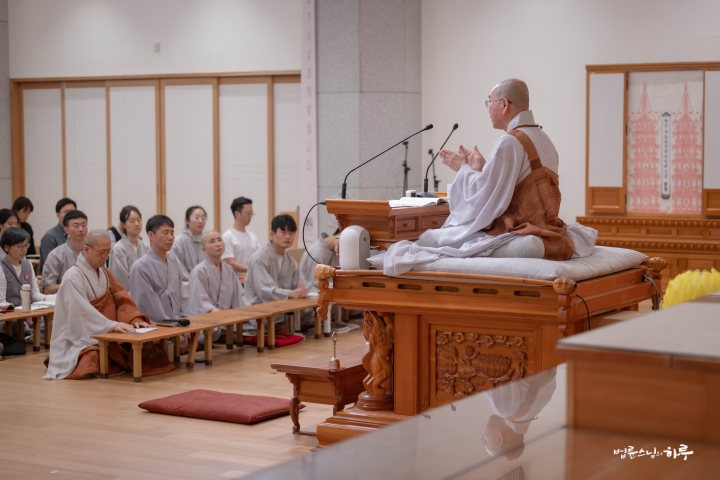
Break Free from Dogmatism: The Teaching of Coexistence in the Diamond Sutra and Heart Sutra
With this, Sunim concluded the study of the Diamond Sutra and Heart Sutra. The greatest teaching these two sutras offer us is to break free from dogmatic assertions like “This is right” or “That is correct.” However, this doesn’t mean we shouldn’t think at all. It’s perfectly fine to say “I think this way,” “I believe in this,” or “I prefer this.” But the moment we assert “This is right!” or “This is the truth!” we fall into attachment to dharma (法執).
Furthermore, going beyond “I think this way” to invoke authority by saying “The Buddha also said this” or “Venerable Pomnyun Sunim also said that” represents an even stronger attachment. When we rely on authority like this, it becomes even more difficult to resolve problems. While religion is originally meant for peace of mind, when it leans on authority, it can become a cause for prolonging conflicts rather than resolving them. This is why religious conflicts can persist for over a thousand years.
No matter how stubborn a person may be, they can still hold the thought “I might be wrong.” That’s why disputes between individuals can be resolved in a few years, and even wars between nations can lead to restored diplomatic relations after several decades. After the Japanese invasions of Korea (1592-1598), Joseon still sent diplomatic missions to Japan to resume relations, and the Republic of Korea established diplomatic ties with Japan just over 20 years after the Japanese colonial period. However, the closer the relationship, the deeper and longer-lasting the conflicts tend to be. The war between North and South Korea is now in its 75th year. While the fighting has stopped, legally we remain in a state of war because no peace agreement has been signed. Now we must end this war.
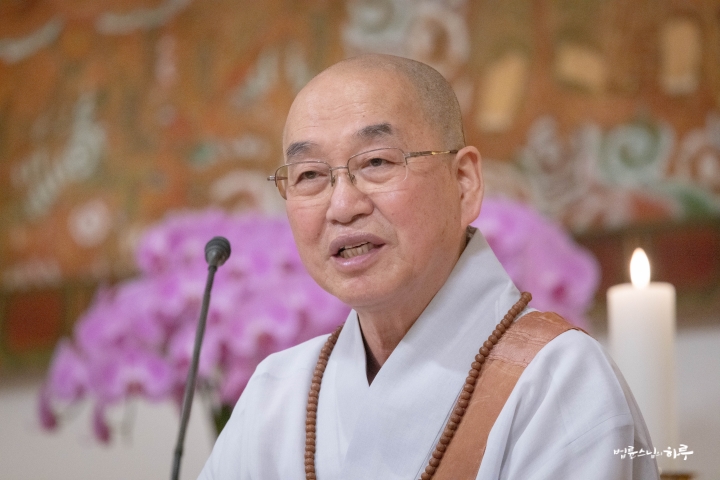
To reduce conflict, we must not be too rigid about anything. When circumstances change, our responses must adapt accordingly. Even if wars were fought in the past, fighting again now would only bring mutual harm. That’s why dialogue is necessary. The same applies to our relationship with Japan. While it would be ideal to resolve historical issues, reality doesn’t always allow for it. Yet we cannot sever diplomatic relations either. Moreover, in today’s world where the United States and China are engaged in a hegemonic competition, a small country like ours cannot side with just one power – we must cooperate with both. This doesn’t mean we should ignore historical issues and cooperate blindly. Conversely, if we say “Let’s cooperate only after resolving all historical issues,” cooperation becomes impossible. We must work to resolve historical issues while simultaneously pursuing cooperation for the future.
This approach is what Buddhism calls the “Middle Way” and “No Everlasting Abiding Dharma.” While these concepts may sound somewhat unrealistic, they are actually very practical. Even what we believe to be reality often turns out to be just our own thoughts that we’ve mistaken for reality. It could be a kind of dream. This is why we have political divisions between ruling and opposition parties, conflicts between progressives and conservatives, and regional tensions. When you visit one region and listen to the people there, they believe they are right. But when you go to another region, those people also believe they are right. This happens because they’ve grown up seeing and hearing certain narratives that they’ve shared among themselves. Having been raised this way, they can’t help but think as they do. That’s why we shouldn’t conclude that someone is wrong just because they’re different from us – we need to accept that we’re simply different.
The reason for studying Buddhist scriptures and learning the Buddha’s teachings isn’t just to find peace of mind for ourselves. We must also learn the Buddha’s teachings to more wisely resolve the conflicts that exist in our society. We often create conflict by thinking someone is wrong when they differ from us. However, when we acknowledge and understand our differences, those differences become diversity. With this perspective, we can create a society where different ideas can harmoniously coexist. With these words, I conclude our lectures on the Diamond Sutra and the Heart Sutra.”
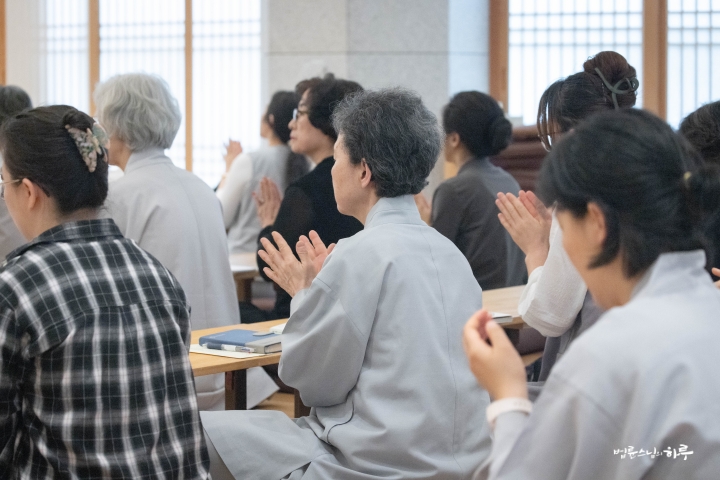
With this, the sutra lectures were completed. Next, there was time to wrap up the sutra lectures. A bouquet of flowers was presented to Sunim with gratitude for giving lectures for 100 days.
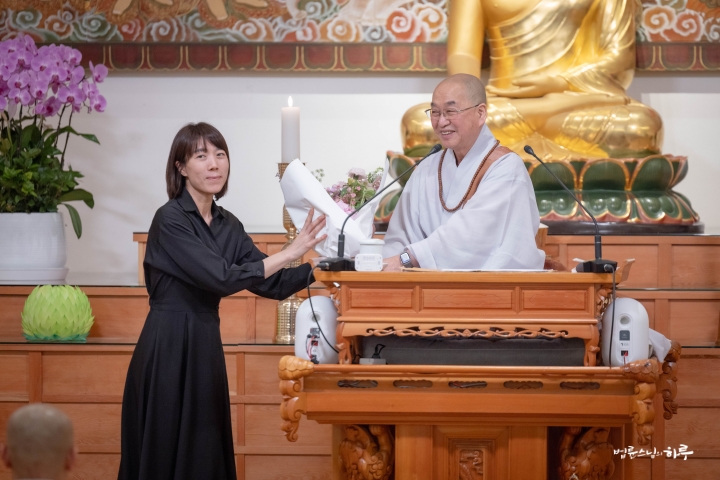
Following this, Sunim personally introduced the volunteers who took on various responsibilities throughout the 100 days to make the sutra lectures possible.
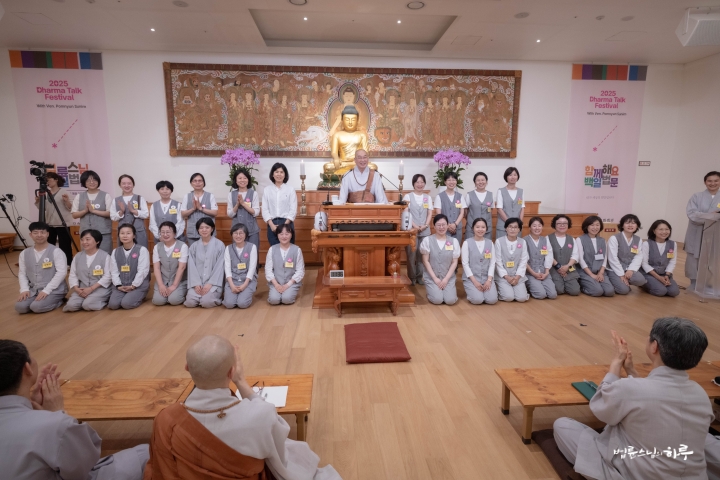
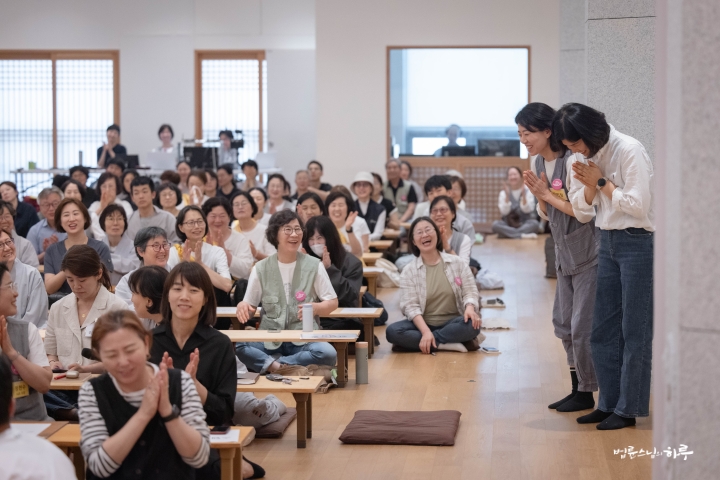
“There are no paid employees at Jungto Society. Everything is run by volunteers. Today, I would like to introduce the volunteers who conducted the sutra lectures. Please come forward.”
All the students expressed their gratitude with loud applause.
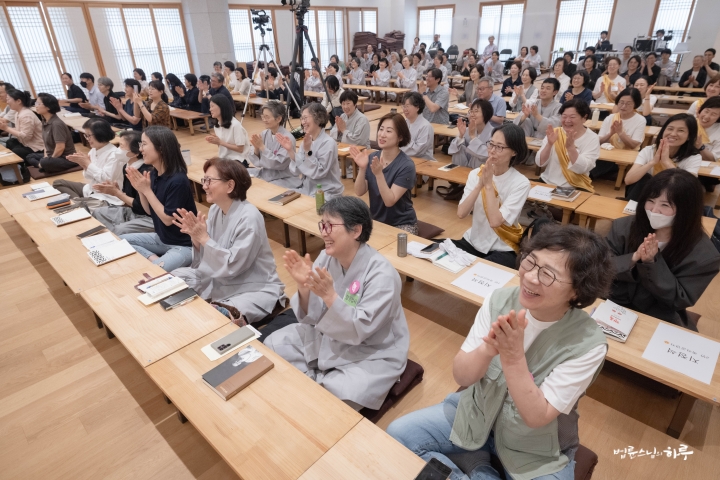
After taking a commemorative photo together, Sunim gave words of encouragement.
“Since you asked me to give words of encouragement, I will give you encouragement.”
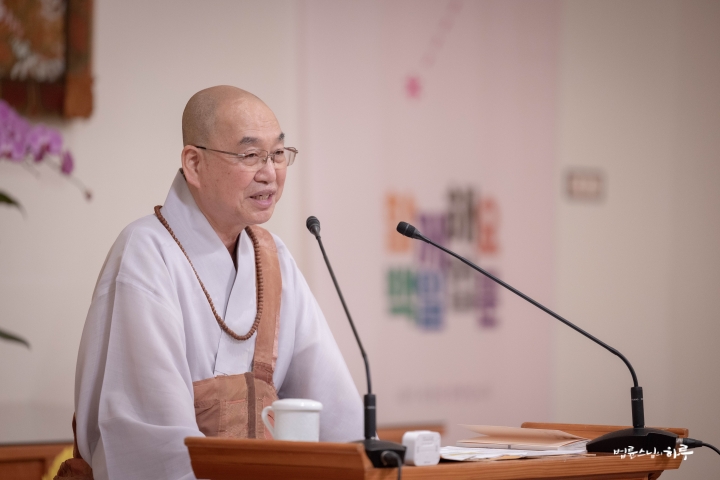
Next, two people came forward representing the volunteers and shared their thoughts in turn.
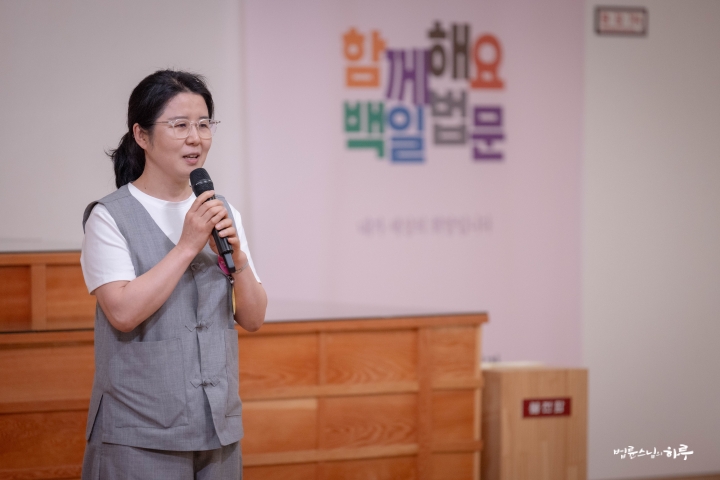
“When I was just attending classes, I felt like a guest, but when I started volunteering, I became an owner. Instead of just coming to listen to Dharma talks by myself, I encouraged other students to come for meditation and to do 1,080 prostrations. After 100 days, I had transformed into an owner of Jungto Society. Thanks to that, I was able to listen to precious Dharma talks, and it was a grateful time.”
“Among the staff, there were people who volunteered while commuting 4 hours round trip by bus, and there were people who volunteered not just one day a week but three or four days. Watching people volunteer so devotedly, I actually learned a great deal.”
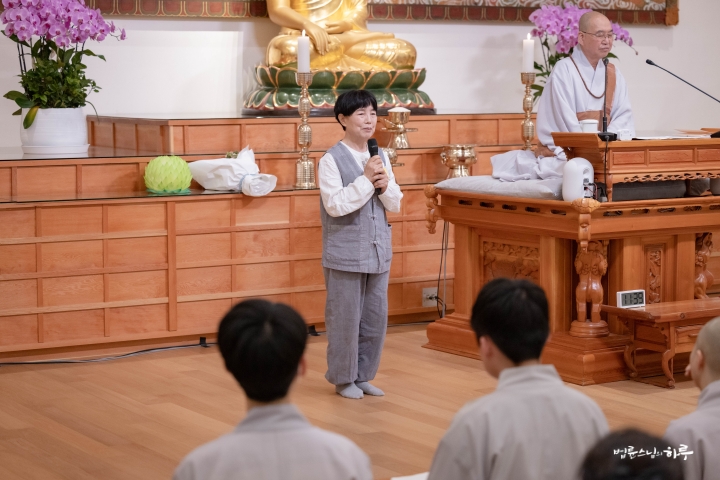
Next, two people came forward representing the students and shared their thoughts in turn.
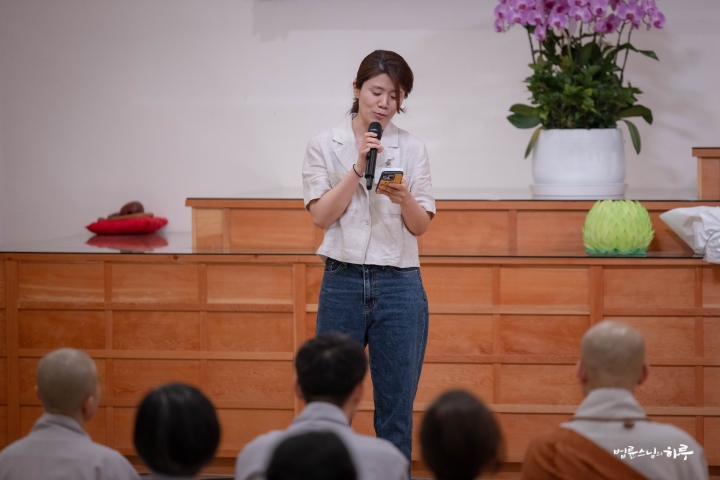
“I have been a fan of Sunim, reading A Day in the Life of Sunim every day for the past 5 years. While I was attending the sutra lectures, my daughter entered high school. It was difficult because my daughter was always in tears, saying she didn’t want to go to school. But while listening to the sutra lectures, I gained the strength to understand and wait for my daughter. Now I have the desire to enroll in Jungto Dharma School, which I had been curious about while reading A Day in the Life of Sunim every day.”
“It was very helpful that Sunim explained how to apply sutra passages to reality. Now, whenever I get frustrated because things don’t go my way, I look back at myself. The Dharma talk that remains most memorable is about the bodhisattva’s spirit of benefiting oneself and others. Thanks to Sunim, who shows us that benefiting others is the way to save ourselves, and the volunteers who always come early to prepare for lectures, I too am taking a step on the path of benefiting myself and others. Sometimes I may flicker in the darkness, but I believe this is the right path and will continue steadily.”
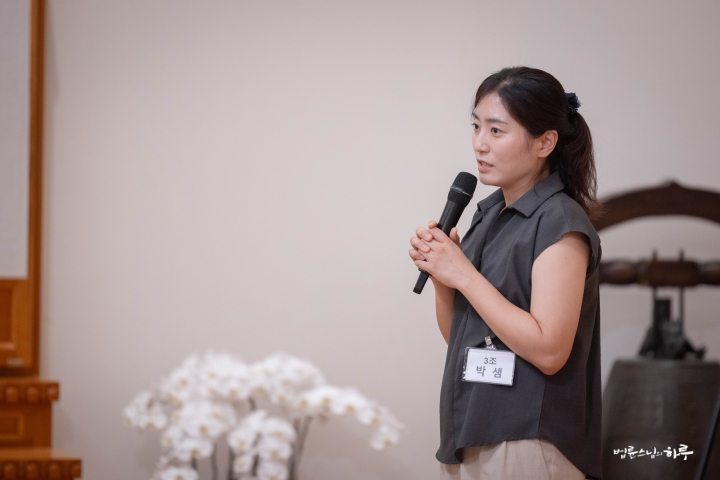
Everyone expressed their empathy with loud applause. Although everyone’s circumstances and situations were different, it was a precious time to move a little closer to happiness using Sunim’s Dharma talks as a guiding light.
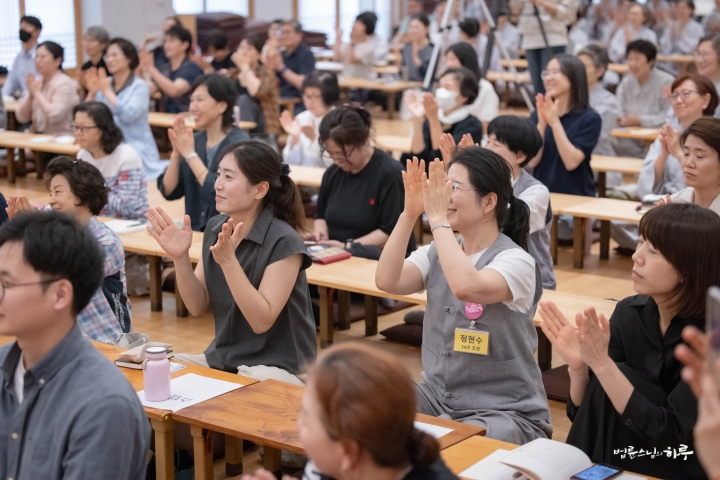
Next, they watched a performance that the students had carefully prepared with gratitude for Sunim. First, they rewrote Na Hoon-ah’s song with content learned from the sutra lectures and performed it with dance and song.
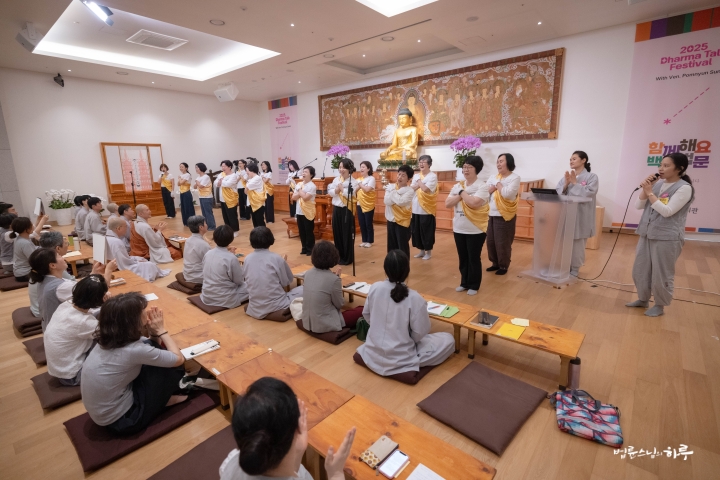
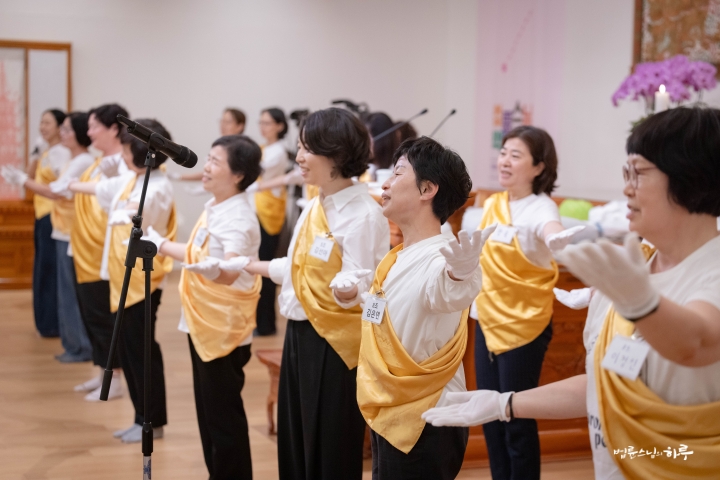
Next, they presented a short play depicting the graduation day from the Buddhist elementary school created by Master Yongseong. After finishing the play, everyone sang Jindo Arirang together enthusiastically.
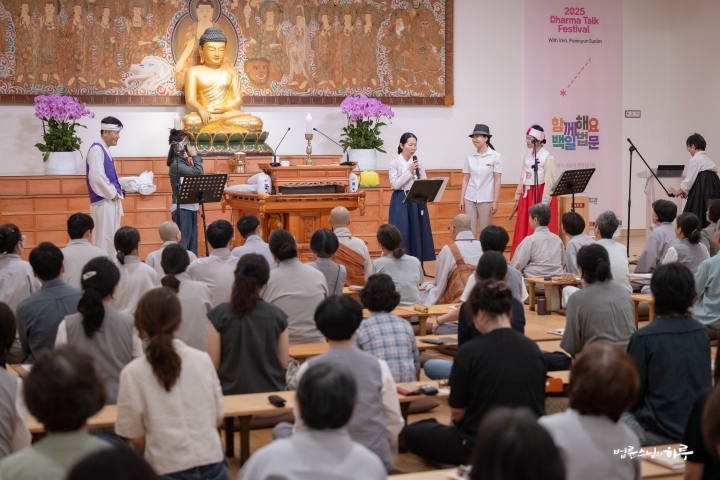
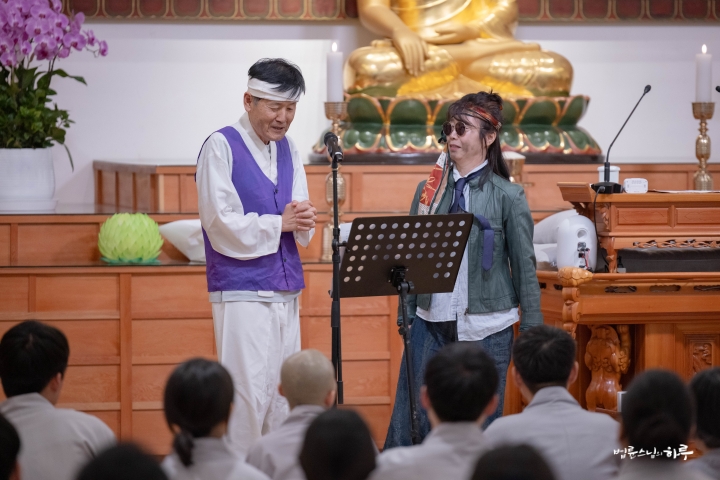
The sutra lectures are a huge hit ♬
What luck to study, my eyes opened wide!
Ari-arirang, sseuri-sseurirang, ararari has come ♬
Arirang hmm hmm hmm, ararari has come
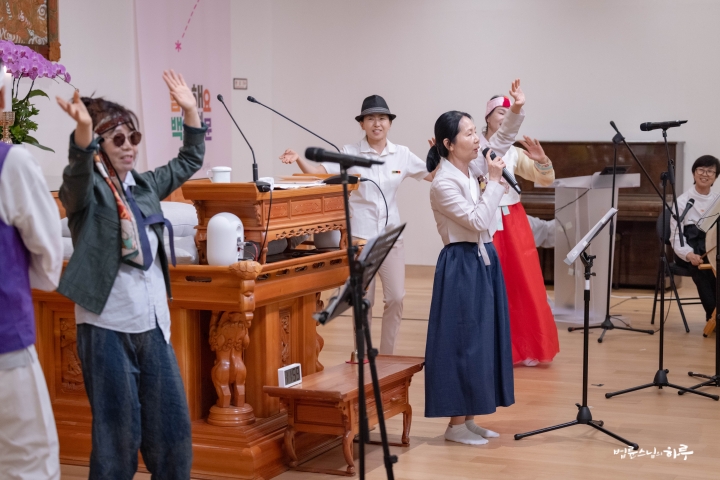
Everyone swayed their shoulders to the lively performance. When the host said, “This place where we can listen to Venerable Pomnyun Sunim’s sutra lectures seems to have been paradise itself,” everyone gave applause of agreement.
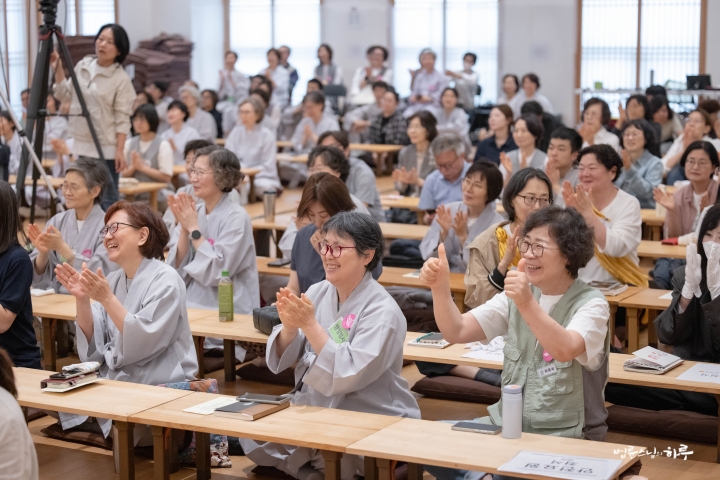
After joyfully celebrating the successful completion of the course, the 100-Day Dharma Talk sutra lectures concluded with the Four Great Vows. Starting next week, open Dharma assemblies will continue to be held every Thursday in the 3rd floor Dharma Hall in video lecture format.
Participants gathered in groups for mindful sharing, and Sunim moved to the underground dining hall to have lunch with the assembly.
From 1 PM, the memorial service for the late Dharma Teacher Hyangryu and the 6th ceremony of the 49-day memorial service began. With the chief mourners, family members, and about 200 members of the assembly in attendance, after offering ceremonial prayers, Jeon Hae-jong, President of Jungto Society, offered incense representing the guests.
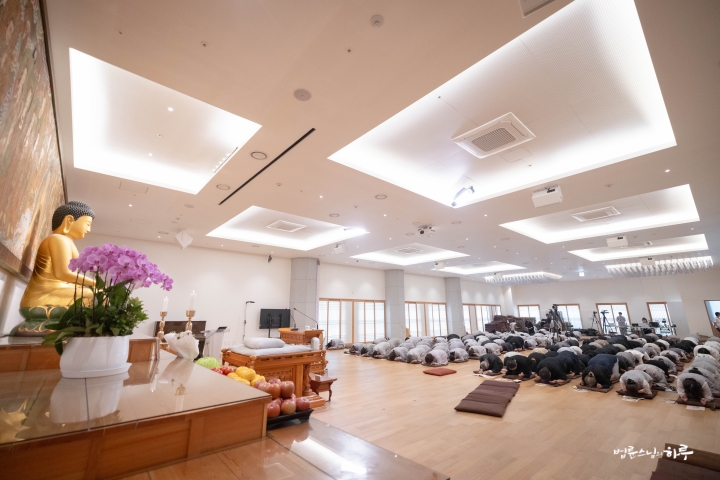
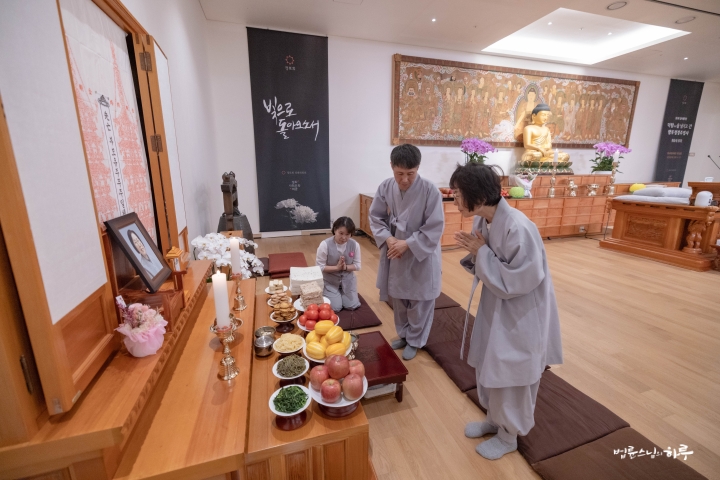
Next, the eldest son Kwak Bong-jun, representing the chief mourners, offered tea before the spirit tablet, and the chief mourners bowed three times together.
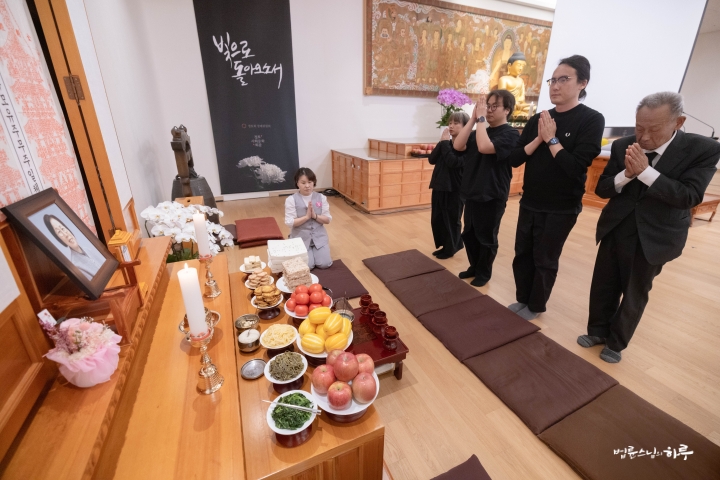
Next, they watched a video of the deceased’s life journey together. Through the video, they were able to cherish the deceased’s appearance during their lifetime in their hearts.
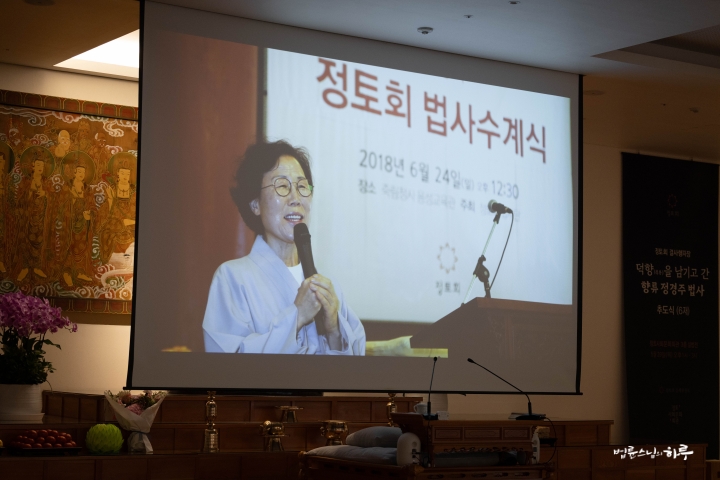
Following this, they listened to memorial addresses. Kim Bok-i from the Cheonan branch of the Daejeon-Chungcheong division and Jeong Ji-an, a Happiness School facilitator from the Happiness Movement Headquarters, shared their connections with Dharma Teacher Hyangryu.
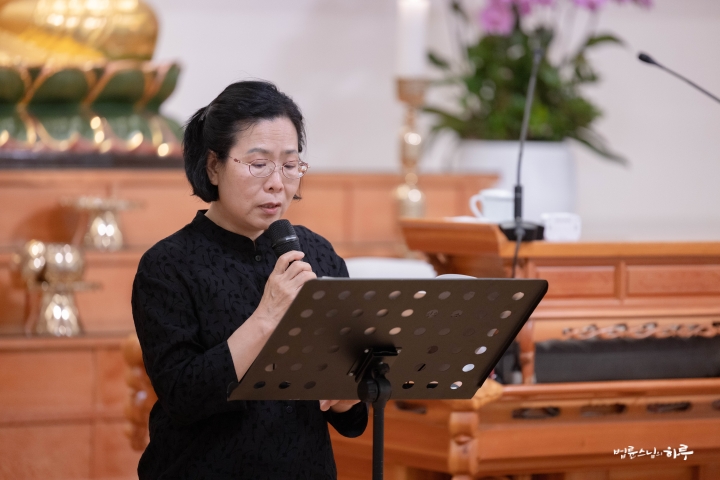
“The Dharma Teacher was always equal to everyone, humble and dignified, a person full of the fragrance of character. I could feel and learn so much, thinking ‘This is how one should practice.’ I could reflect on myself…”
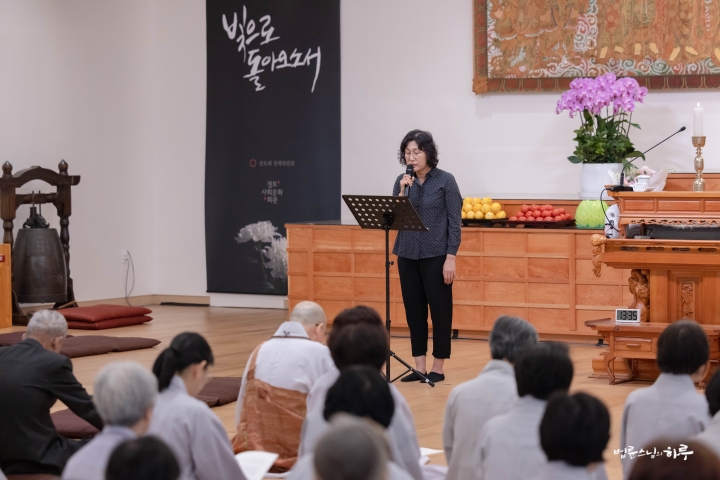
“When I first started volunteering and ran out of the Dharma hall, when I was struggling with conflicts with fellow practitioners, the Dharma Teacher led me by the hand like caring for a lost lamb, and transformed me from being wild and unruly into someone trustworthy. To me, you were the Buddha. You always showed us what simplicity is and how to give truly with your upright posture as an example…”
After listening to the memorial addresses, the gentle appearance of the Dharma Teacher during their lifetime seemed to be vividly depicted.
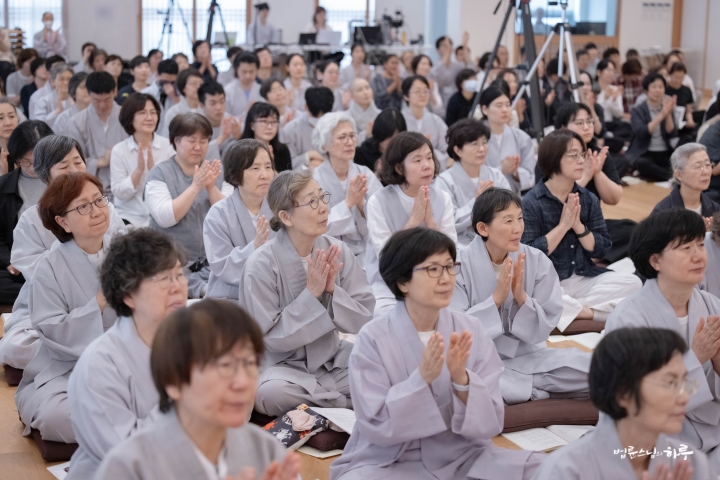
Next, members of the Jungto Society Cheonan branch sang a memorial song in chorus. When Lee Seung-chul’s “There’s No One Like That Person” echoed through the Dharma Hall, everyone’s eyes reddened as they remembered Dharma Teacher Hyangryu.
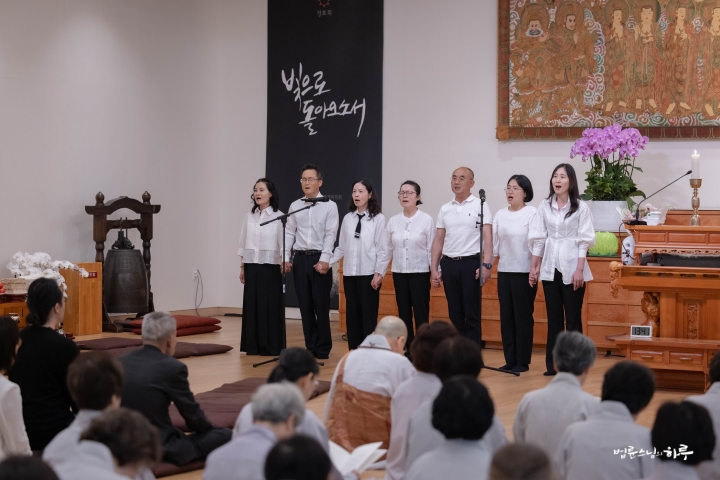
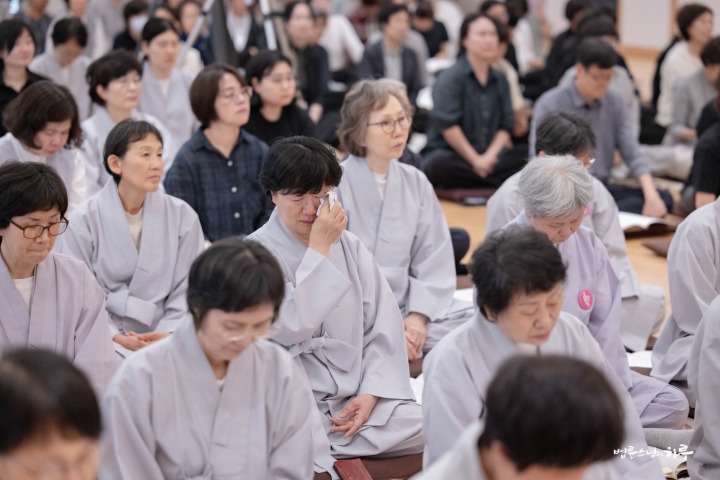
Following this, they sang together the memorial song “Dear One, Go Well,” praying for the deceased’s rebirth in the Pure Land. The longing and gratitude toward the deceased flowed quietly, carried by the lyrics.
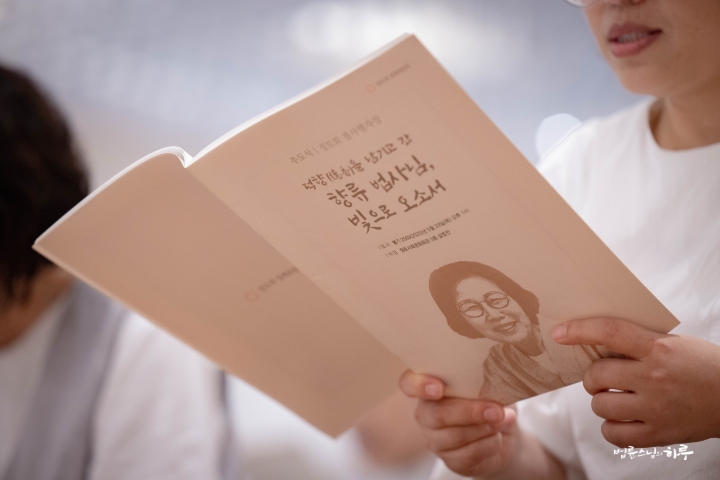
The attending assembly requested a memorial Dharma talk from Sunim with three bows. Sunim spoke about what contributions Dharma Teacher Hyangryu made to Jungto Society and then talked about what kind of mind we should have to truly commemorate the deceased.
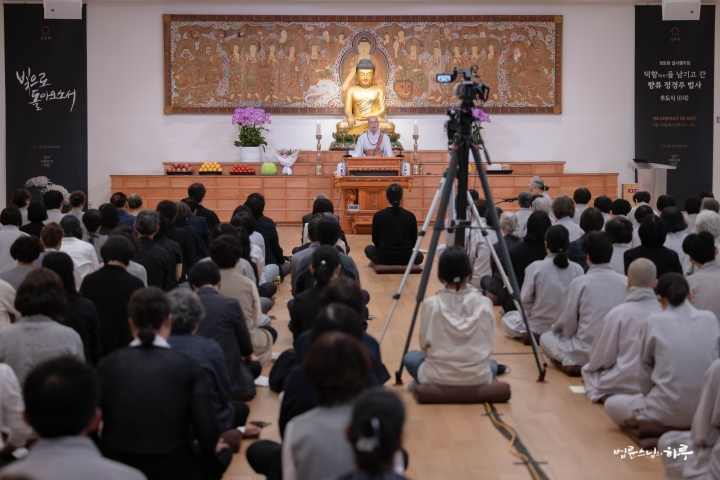
“Today is the sixth ceremony of the 49-day memorial service for guiding the spirit of Dharma Teacher Hyangryu. Dharma Teacher Hyangryu played a major role not only in helping Jungto Society take root in the Daejeon area but also in spreading it to South Chungcheong Province, North Chungcheong Province, and even Sejong City. Furthermore, she played an important role and had a significant influence in spreading Jungto Society in Gwangju and the Jeolla region. It is rare even within Jungto Society to find someone who devoted all 24 hours of the day entirely to practice and Dharma propagation activities. Perhaps that’s why Dharma Teacher Hyangryu’s absence feels even greater and the longing among Jungto Society members has deepened, bringing so many people together for today’s memorial service.
However, from a practitioner’s perspective, even when a great teacher like the Buddha passed away, practitioners did not remain only in sorrow. Rather, they gathered to compile the Buddha’s teachings into sutras and organized the remaining assembly well. Thus, they spread this Dharma more widely throughout the world than when the Buddha was alive. The Buddha who passed away was one person, but countless practitioners called Bodhisattvas, who could be considered his manifestations, scattered throughout the world to spread and continue this good Dharma.

Considering the conditions of that time, it seemed like an impossibly distant journey. The Dharma traveled from India, crossing the Hindu Kush mountains, passing through Central Asia and China, and finally reaching the Korean Peninsula. Master Marananta brought the Dharma to Baekje, Master Sundo to Goguryeo, and Master Ado, called Mukhoja meaning “the black-faced one,” to Silla. Additionally, following the southern sea route through tens of millions of li of perilous journey, Master Jangyu from Ayuta Kingdom in India and Princess Heo Hwang-ok arrived in Gaya to spread the Dharma. I hope that all of us gathered here today can once again reflect on how this Dharma has been transmitted through this historical journey.
Remembering Dharma Teacher Hyangryu, We Will Now Continue That Path
If we long for the fragrance of practice that Dharma Teacher Hyangryu embodied and wish to commemorate her, what we must do is clear. We must continue in our own lives the path she walked and the path she intended to walk. Spreading widely the Dharma and spirit of practice she tried to convey, so that people in the world can become even a little more free and happy—this is what Dharma Teacher Hyangryu would find most joyful and meaningful.

Now we must each take on a portion of the work that Dharma Teacher Hyangryu did and live together as a mosaic Buddha. If we do this, we will be able to accomplish even more than when she was alive and achieve deeper practice. We must spread this wonderful Buddha Dharma widely to every corner of the country, and we must lower the threshold to spread the Dharma according to people’s level of understanding, regardless of their different religions or generations. Furthermore, we must continue spreading the Dharma beyond Korea to the world, transcending language barriers. This is the commitment we must engrave deeply in our hearts today as we commemorate Dharma Teacher Hyangryu.
Listening to your memorial addresses, even without saying “May she go to the Pure Land,” Dharma Teacher Hyangryu has already reached the Pure Land, received by Amitabha Buddha, and is there listening to Dharma teachings and practicing diligently. This doesn’t mean the memorial service is unnecessary. Although we know this to be true, we hold the memorial service to remove any remaining doubts and ensure completeness. I believe that Dharma Teacher Hyangryu has not only gone to the Pure Land but will reject even that comfort and return here to practice, spread the Dharma, and engage in practical activities with us. Since there is originally no self to speak of, she will not return here with a particular name but will be inherent in all of you in various forms, continuing her activities.

Today, on the memorial day of Dharma Teacher Hyangryu, if you take her life of practice, spreading the dharma, and service as an example and make it your own path with sincere aspiration, then Dharma Teacher Hyangryu has already come back to life within you. If I don’t make such an aspiration, even if she were beside us, we wouldn’t be able to truly know her. Therefore, we shouldn’t simply hold a memorial service, but need to have the mindset to inherit and carry on her will. If we make such an aspiration here today, Dharma Teacher Hyangryu has already been fully liberated. Then there’s no need to cry in sorrow or feel regret anymore. This is because she already lives and breathes within me as part of myself.
We must liberate Dharma Teacher Hyangryu by making new aspirations like this. Jungto Society is a gathering of practitioners who follow the Buddha’s teachings through practice and dedication, and with their remaining energy, spread the dharma and realize Jungto. If we dwell on the past, only sadness and regret remain, but if we look toward the future, hope and joy unfold before us. As we dedicate the merit of the 49-day memorial service for Dharma Teacher Hyangryu, I hope everyone will step beyond the past and move forward into the future.”
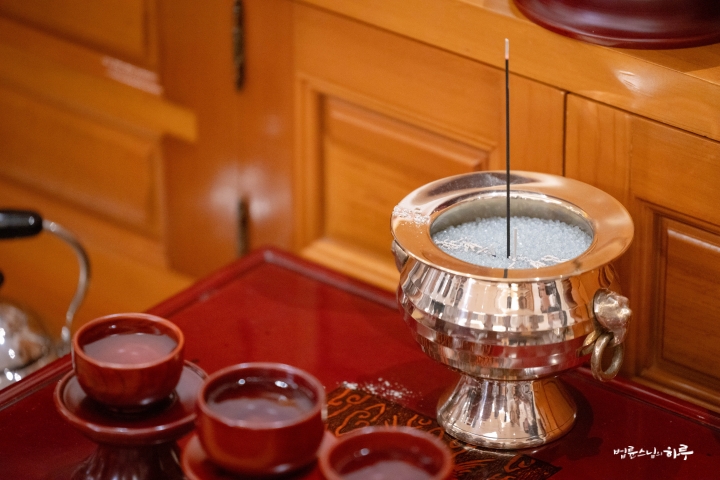
After engraving the Dharma talk in their hearts and entering meditation, everyone chanted solemn Buddhist hymns together, praying for the peaceful transition of the deceased’s spirit. The chief mourners first offered tea at the altar, followed by the congregation who came forward in turn to offer tea.
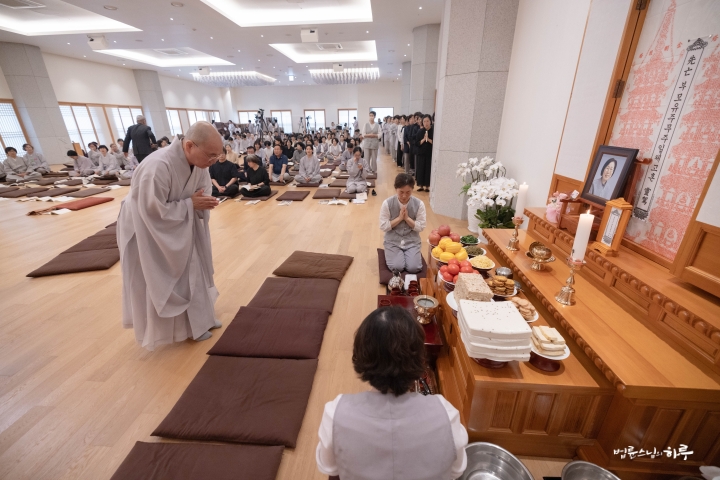
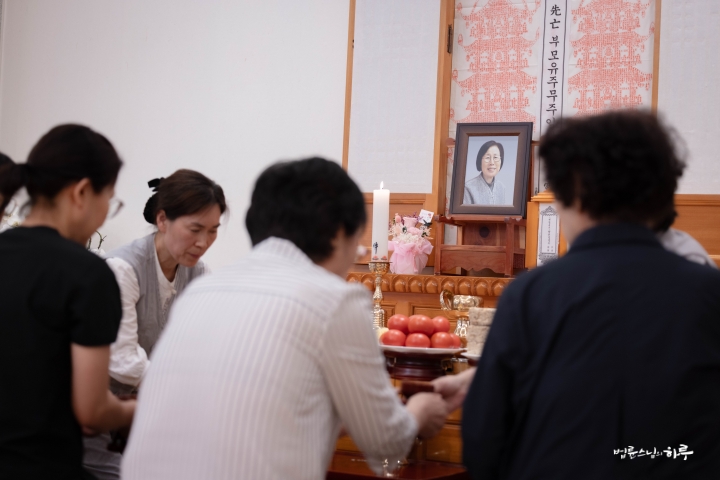
After the prayer for the peaceful transition of the deceased’s spirit ended, there was time to hear words from colleagues and acquaintances of Dharma Teacher Hyangryu. Dharma Teacher Hyangyeom and Kim Jeong-mi shared their reflections. Listening to their reflections, heads naturally bowed in respect for the deceased who had lived uprightly as a practitioner and never forgot to maintain a bright smile.
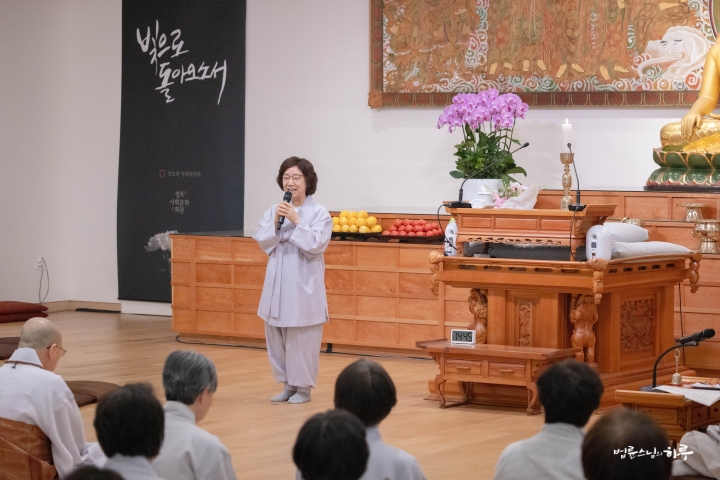
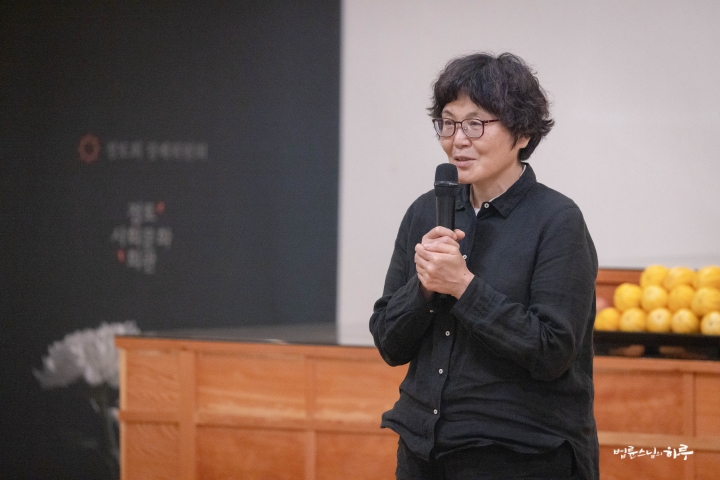
Next, everyone sang “With Love” together, holding the intention not to forget the love that Dharma Teacher Hyangryu had given us. Holding hands and singing together, they remembered Dharma Teacher Hyangryu who had practiced warm sharing.
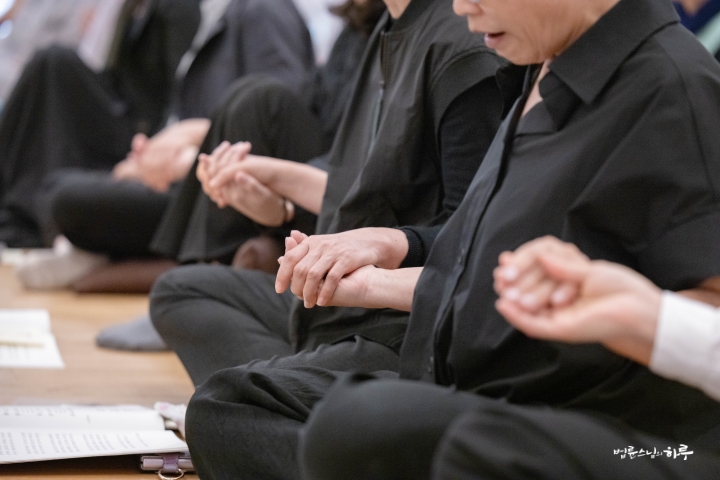
Next, Mr. Kwak Bong-jun, representing the chief mourners, gave a greeting to the congregation in attendance.

“Thank you to everyone who attended the memorial service. Actually, since my mother became a monastic long ago, she doesn’t belong to our family. Even at home, we thought of her more as a Dharma Teacher than as our mother. But anyway, since I am the chief mourner, I feel I should express my gratitude to those who attended today. (laughter)
I cried a lot during today’s memorial service. I think I was sadder because I had a good relationship with my mother. It was a time when I could observe that I have a lot of attachment to my mother. I received a great gift while caring for my mother, and I hope each of you will cherish the gifts you received from her.”
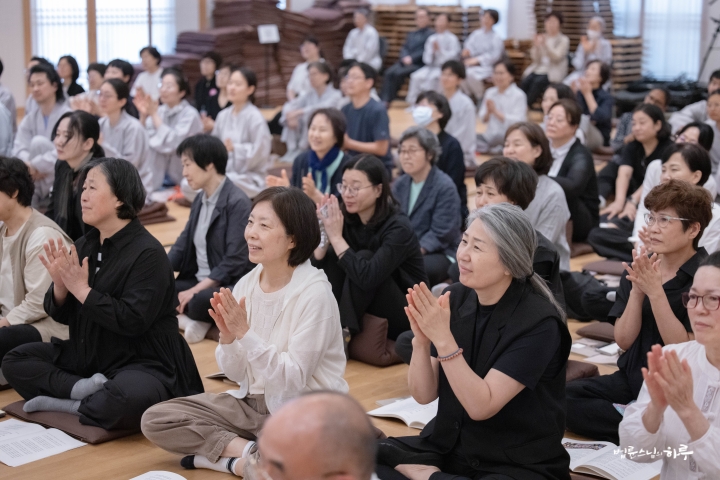
Finally, Mr. Kwak Young-sul, the deceased’s husband, gave closing remarks for the memorial service.

“My wife had a persistent nature, whether spreading the Dharma or in everything she did. If something didn’t work today, she’d try again tomorrow. If it didn’t work this month, she’d try again next month. If it didn’t work in spring, she’d try again in fall. It was the same when she sent me to the Awakening Retreat. When I firmly refused saying ‘I won’t go!’, she gradually persuaded me, saying ‘Then at least go take a look first!’ That’s how I became connected with Jungto Society, and it’s already been 30 years. Looking back now, I think the greatest gift my wife gave me was connecting me with Jungto Society. I gave her a lot of trouble by not listening to her, but for the rest of my life, I’ll listen well to my fellow practitioners and live a life of service at Jungto Society.”
The Dharma hall was filled with touching emotion at his heartfelt greeting. Many had tears in their eyes and conveyed deep comfort with warm applause.
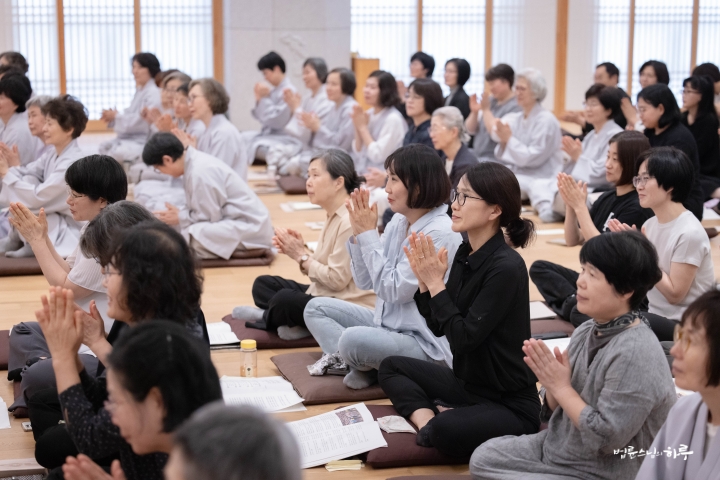
After concluding the memorial service with the Four Great Vows, everyone took a commemorative photo together. The attendees went to the basement dining hall for refreshments and conversation with the chief mourners before returning home.
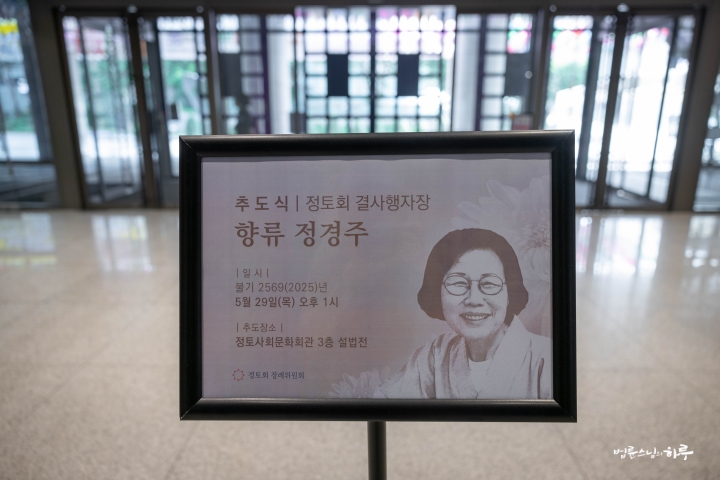
After sunset, at 7:30 PM, the 23rd and final lecture of the Buddhist Social Studies Course began in the underground auditorium of the Jungto Social and Cultural Center. About 170 people attended in person, and approximately 1,900 people connected online.
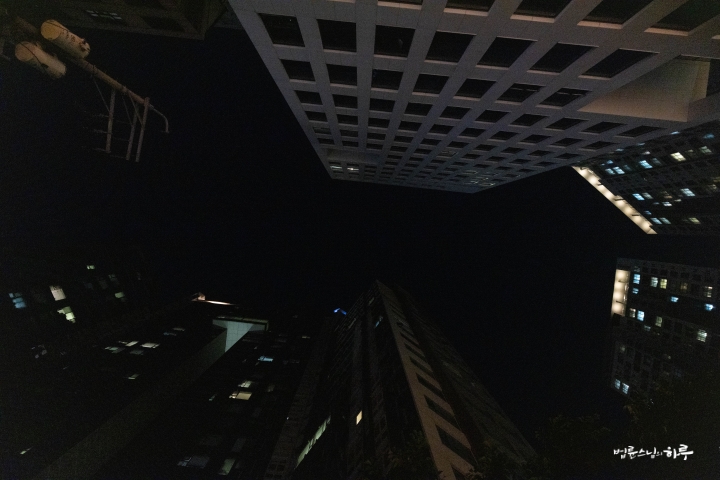
In the previous session, under the theme “Buddhist Wisdom for Dealing with Social Trauma,” factors affecting modern people’s mental health were examined and solutions were explored. Today, the final lecture continued with the theme “Civilization Transformation and the Role of Buddhism from Buddha’s Perspective.”
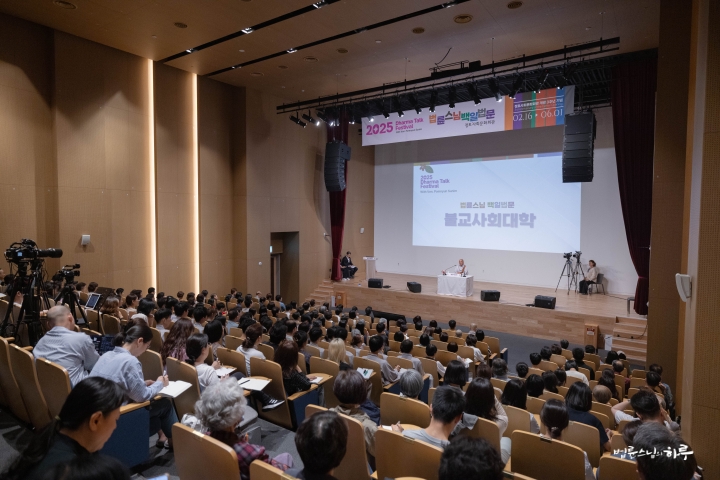
“Today, our standard for ‘living well’ is producing a lot and consuming a lot. Psychologically too, consuming a lot is considered living well, and the higher the consumption level, the better one is thought to be living. So we can say that the standard for measuring whether we are living well or not depends on our consumption level.
Is Consuming a Lot Really Living Well?
However, to consume, production must keep up. To consume in large quantities, mass production must support it. In the past, slaves were mobilized to enable mass production. A minority controlled the majority to produce necessary goods. Then, people with large amounts of land used their vast territories for mass production and accumulated wealth. Later, as we entered the industrial society, the current mass production system was established with capital and technology at the forefront. However, this mass production system requires many resources. So we eventually ran into the problem of resource depletion. Then how can we solve the resource shortage problem?
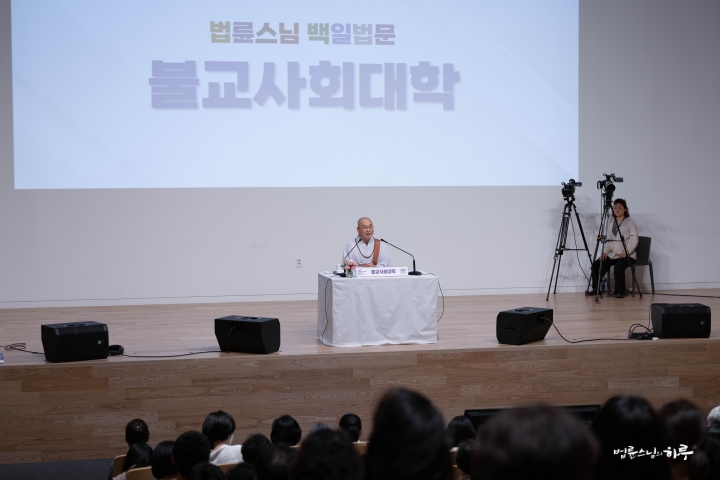
First, there’s the method of securing resources through competition. Like the approach President Trump is showing these days, pushing through with force to secure resources. However, this method risks leading to war. Second, there’s the method of creating artificial resources through technology. Plastic is a representative example. But this also has problems. Artificial resources haven’t been properly verified for long-term safety or what side effects they might have. While natural resources have revealed their side effects over tens of thousands to hundreds of thousands of years, artificial resources haven’t been verified, so we could be exposed to unknown dangers. So now we’re not just facing the problem of resource shortage. We’re dealing with complex problems surrounding those resources as well.
Initially, “How to solve resource shortage” was humanity’s major challenge. Competition and conflicts over resources continue even now. However, one problem has emerged much faster than expected: waste from mass consumption. This problem is appearing much more seriously and rapidly than anticipated. Just 30 years ago, resource depletion was the main concern, but now the side effects of mass consumption – climate change and microplastic problems – are approaching as much more threatening issues.
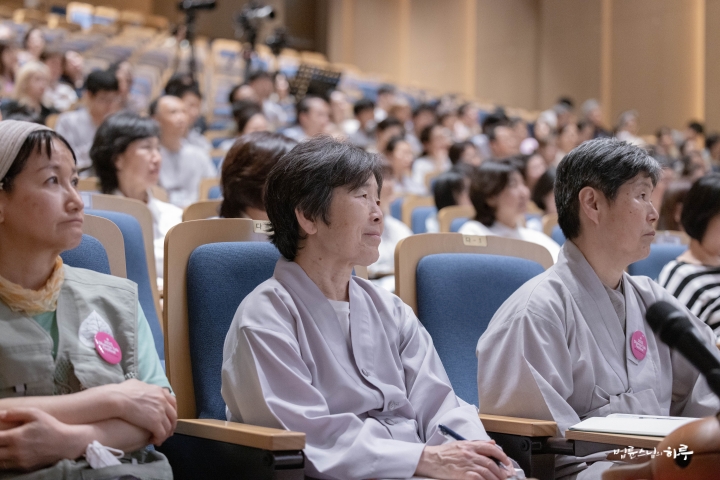
Can We Truly Live Happily While Reducing Consumption?
The idea that “consuming more means living better” didn’t suddenly appear recently. It has gradually expanded since the beginning of human civilization and has become a complete value system of development under capitalism. Until ancient and medieval times, the standard that material consumption equals living well wasn’t so absolute. Even in the Joseon Dynasty, being a scholar didn’t necessarily mean one had to be wealthy. While we no longer distinguish between social classes today, the tendency to evaluate people based on wealth has become much stronger. It’s no exaggeration to say that wealth has now become both the standard of life and almost an absolute value.
This raises the question: “Can we truly live happily while reducing consumption?” To fundamentally answer this question, we must first address another issue: “Can we live contentedly while consuming less?” Without solving this problem, we cannot propose any fundamental solutions. Among various religions and philosophies of the past, some held the view that one could be happy while consuming less. Buddhism can be considered one of these philosophies. However, when you visit temples these days, most people pray for blessings. But the Buddhist perspective that the Buddha originally presented was different from this. This is called practice-oriented Buddhism. Practice-oriented Buddhism teaches that humans can achieve the highest happiness while consuming less, letting go of their authority, and living with a frugal and humble attitude. So looking back at the past, we can say that the answer to “Can we be happy while reducing consumption?” has already been presented.
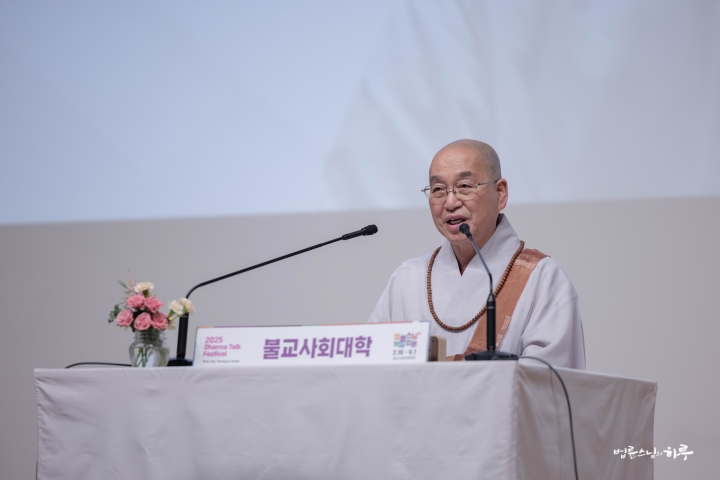
As modern civilization faces a crisis, we must prepare for the future civilization. I believe that the people who will lead the future civilization are bodhisattvas. Bodhisattvas advance toward Buddhahood, but they hold the perspective that this completion is achieved through eliminating the realm of sentient beings. Therefore, bodhisattvas return to the world of sentient beings. This is because the path of saving sentient beings is the path to Buddhahood. This is the bodhisattva ideal.
In this context, the term “Pure Land” (淨土) is not simply some utopia that exists outside. It can be understood as the concept of the Pure Land in the bodhisattva’s mind, or the Mind-Only Pure Land (唯心淨土). For bodhisattvas, the Pure Land is not an already completed world but the very process of moving toward completion. Bodhisattvas are already living in the Pure Land within this process. Therefore, not only the result but also the process is equally important. Just because the result has not yet been completed does not mean that bodhisattvas are not living in the Pure Land.
I engage in many practices while aspiring for peace and unification, but even if unification is not achieved in reality, it is alright. This is because earnestly wishing for unification means viewing the South and North not as separate entities but as one. From this perspective, I can say that I am already living in a unified society. Of course, in reality, I live in South Korea, my nationality is South Korean, and I follow South Korean laws. However, if I earnestly aspire for unification in my heart, I am already living in a world where the South and North are one. If one views the South and North as separate and desires unification, it is ultimately no different from saying we should eliminate North Korea and unify, or eliminate South Korea and unify.
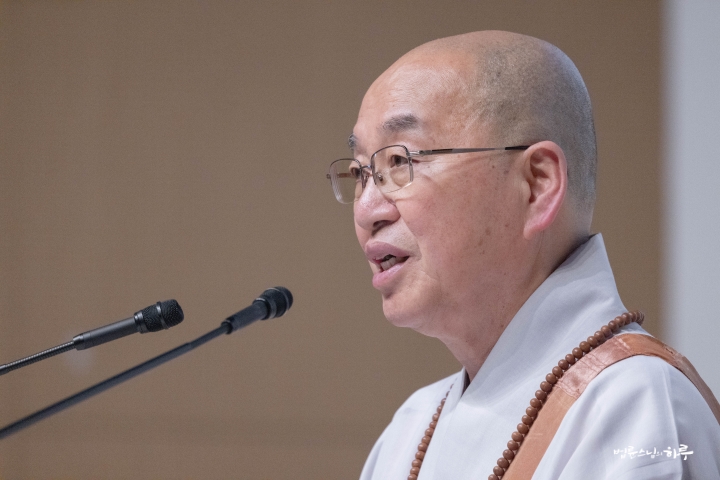
As we conclude the Buddhist Social Studies Course, let’s all recite this passage together.
‘For a bodhisattva, the Pure Land is not an already completed world, but a world where the bodhisattva actively works toward completion.’
This concludes all of our lectures.”
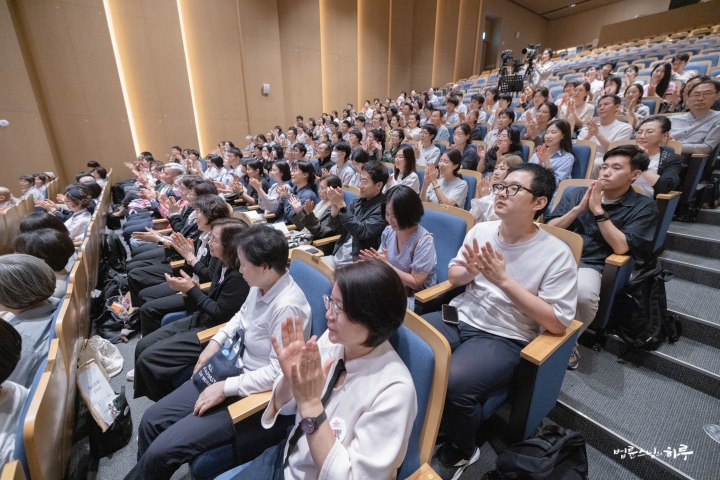
Today, Sunim ended the lecture early and held an extended Q&A session to address questions that had arisen during the course. After answering various questions, he concluded the final lecture of the Buddhist Social Studies Course.
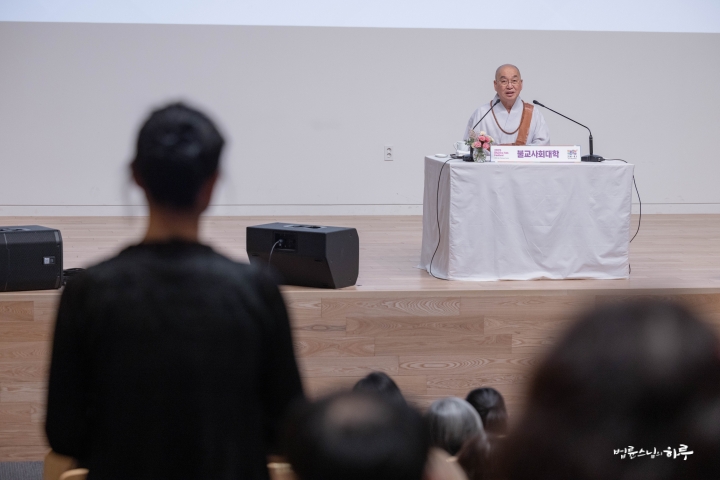
Next, there was time to introduce the volunteers who played various roles behind the scenes to make the Buddhist Social Studies Course possible.
“When I gave lectures, you saw various materials displayed on the screen, right? Do you think Venerable Pomnyun Sunim created these materials? I don’t know how to make them. The Planning Committee Chair of the Peace Foundation and the content team created many of these materials. Also, many people are volunteering to edit the Dharma talks I gave this time into videos to establish the Buddhist Social Studies Course curriculum. Please, everyone come forward.”
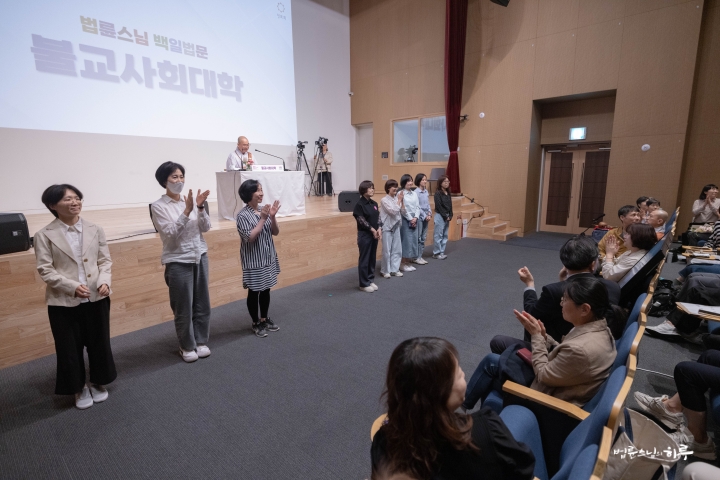
All the students expressed their gratitude with loud applause.
“The Happiness Movement Headquarters took charge of conducting the Buddhist Social Studies Course. All volunteers, please come forward.”
As the team leaders, coordinators, and facilitators were introduced for their respective roles, thunderous applause erupted.
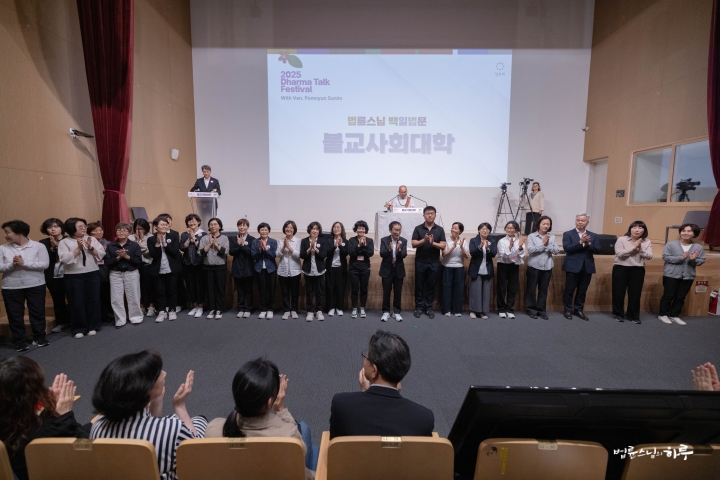
Next, as a conclusion to the Buddhist Social Studies Course, a bouquet was presented to Sunim, conveying the heartfelt appreciation of all students and volunteers.
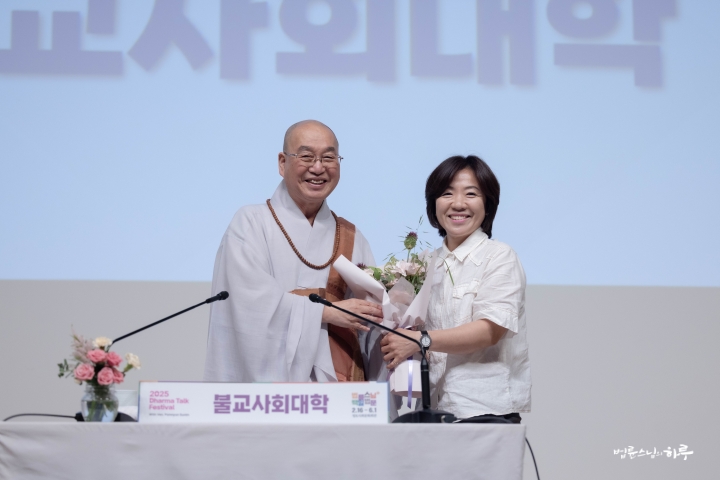
Then, representing the students, Ms. Ahn So-hyun came forward to share her reflections on attending the Buddhist Social Studies Course.
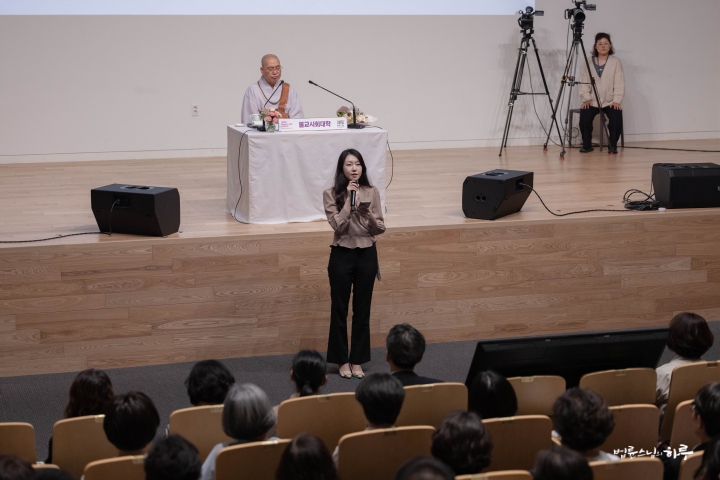
“It was fascinating to see modern social issues from a Buddhist perspective and hear Sunim’s wisdom in addressing them. I was particularly amazed that Buddhism doesn’t contradict scientific principles. During the mindful sharing sessions, it was wonderful to hear diverse perspectives from various people. Through these lectures, the teaching that ‘practice without action is not practice’ deeply resonated with me. Seeing people who practice volunteering not as sacrifice but as a method of practice made me want to live that way too. So from now on, I plan to embrace volunteering as part of my practice and enroll in the Jungto Dharma School and Sutra Course to become a practitioner who combines learning with action. At the end of this journey, I remind myself once again: We are mosaic Buddhas. I and the world are connected as one.”
Next, representing the volunteers, Mr. Oh Hee-seok, who served as a facilitator, shared his reflections.

“I came up from Cheongju to Seoul twice a week to volunteer. By the time I arrived home after the Buddhist Social Studies Course, it was past midnight. I gradually began to feel exhausted. I tried to focus on just the basics, but later even that became difficult. Though my body was tired, my heart was happy. Thanks to Venerable Pomnyun Sunim’s precious Dharma talks, it was an even happier time. I want to continue participating in other volunteer activities.”
After giving a big round of applause to the two people who shared their reflections, the Buddhist Social Studies Course concluded with the Four Great Vows.
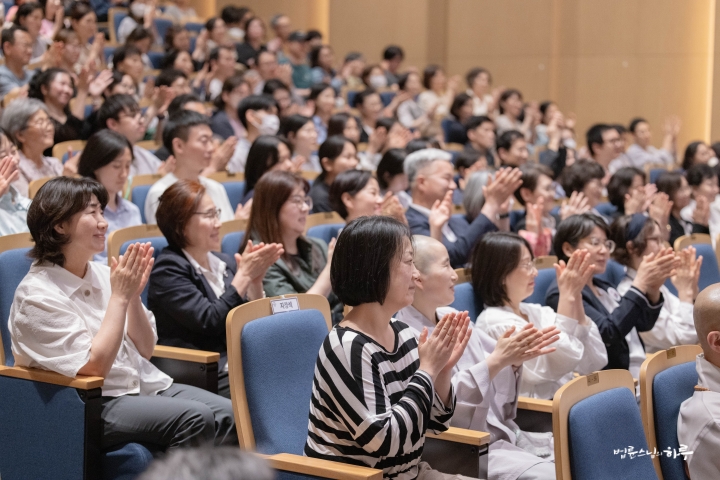
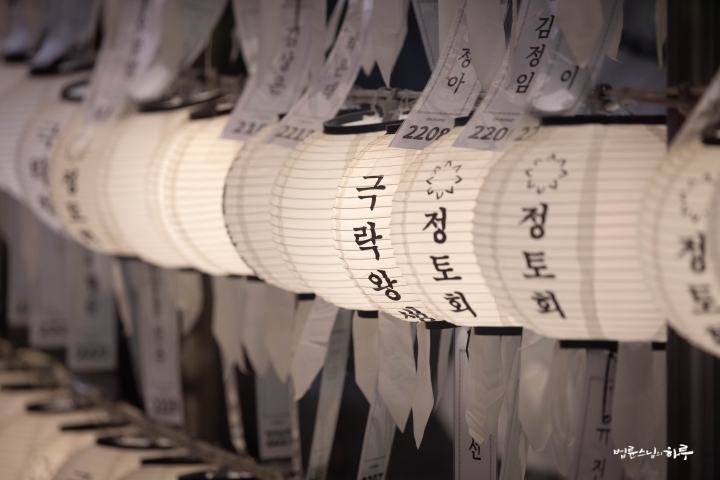
Tomorrow marks the 103rd day of the 100-Day Dharma Talk series. It will be the last Friday Dharma Q&A during the 100-Day Dharma Talk period. In the morning, Sunim will hold a Friday Dharma Q&A for the weekday class in the underground auditorium of the Jungto Social and Cultural Center, and in the evening, he will conduct a Friday Dharma Q&A for the evening class.



